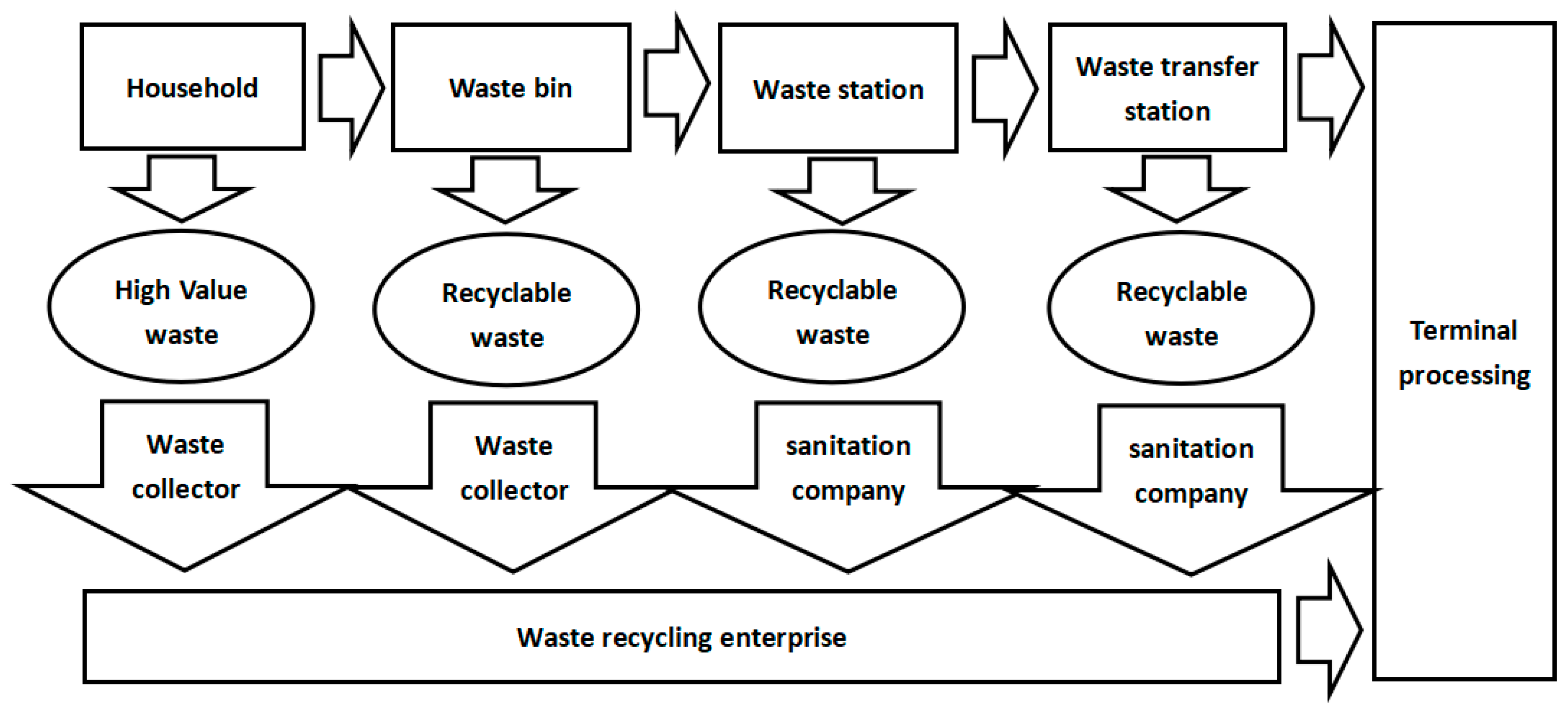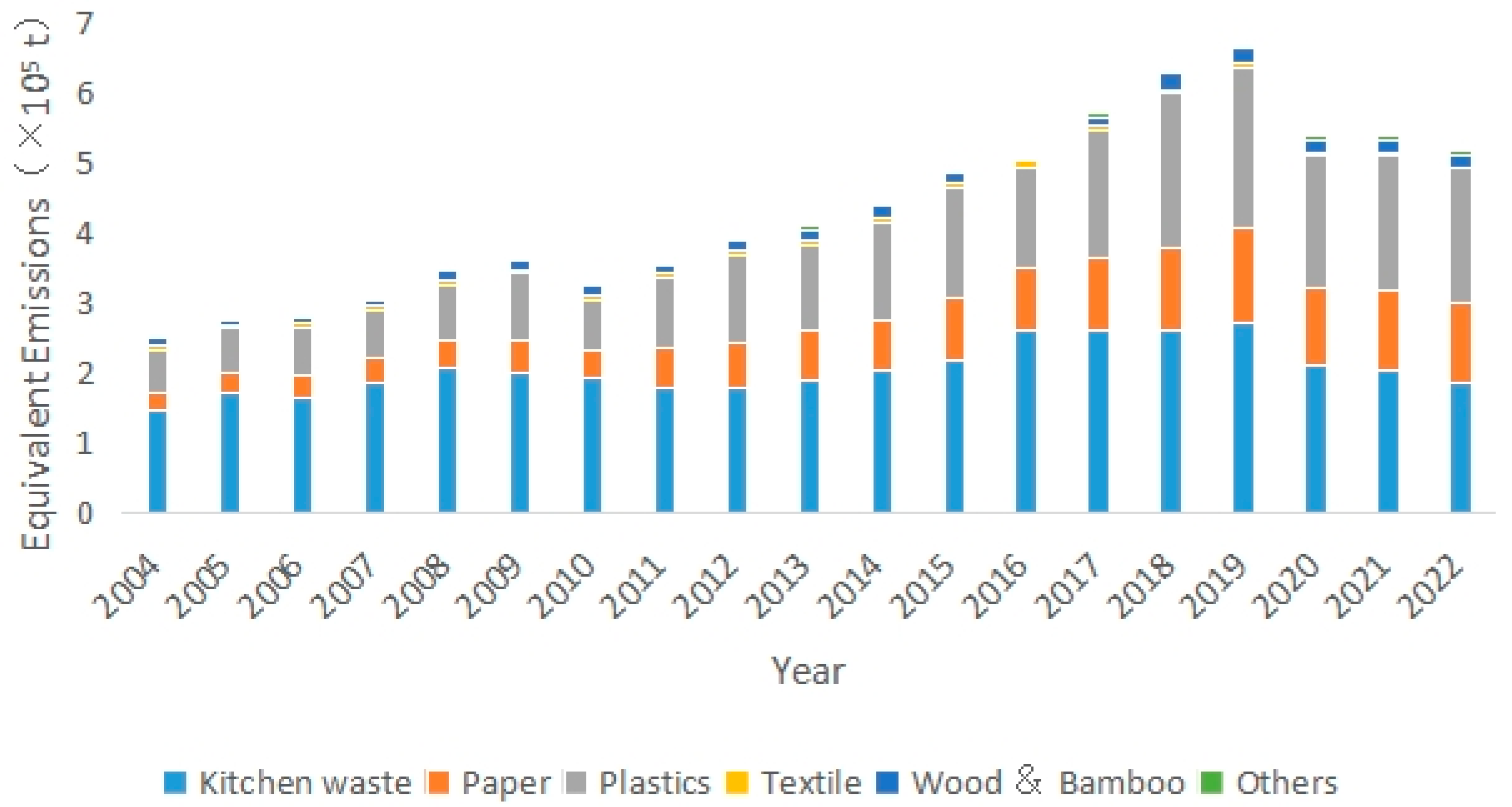Assessment of Municipal Solid Waste Low-Carbon Treatment: A Case Study of Beijing
Abstract
1. Introduction
2. Methods and Data
2.1. Data Sources
2.2. Methods
2.2.1. LCA Goal and Scope Definition
2.2.2. Life Cycle Inventory
2.2.3. Life Cycle Impact Assessment
2.2.4. Analysis of the Carbon Emission Reduction Potential of Municipal Solid Waste in Beijing
3. Analysis Results
3.1. Overview of Municipal Solid Waste Generation and Removal in Beijing
3.2. Characteristics and Changes in Carbon Emissions from Municipal Solid Waste Treatment in Beijing
3.3. Achievements and Future Potential of Carbon Emission Reduction in Municipal Solid Waste Treatment in Beijing
4. Discussion
5. Conclusions and Prospects
- Since the implementation of waste classification treatment in Beijing, carbon emissions from waste treatment have decreased significantly. Carbon emissions from municipal solid waste treatment in 2022 decreased by 22.9% compared with the peak in 2019. Incineration power generation has become the main source of municipal solid waste carbon treatment instead of landfilling.
- The production of plastic and paper waste from municipal solid waste has increased rapidly. Their carbon emissions have become the main component of carbon emissions from waste treatment, accounting for more than 1/3 and 1/5 of all carbon emissions from municipal solid waste treatment, respectively. They are the main source of carbon emissions growth and the main space for future emission reduction.
- In the future, more than 2.6 × 106 t of carbon emission reduction space for municipal solid waste treatment in Beijing will still exist. If it can be used, it will provide valuable carbon space for the economic and social development of Beijing.
- Reduction is the basis for reducing carbon emissions from municipal solid waste. Beijing should start from the source of waste generation; develop a waste recycling responsibility system centered on the producer responsibility system; and gradually promote the whole-process management of production, circulation, consumption and terminal treatment, with reduction as the goal. Enterprises should be actively encouraged to implement the “trade in” of durable consumer goods, improve the durability of products and reduce the generation of large amounts of waste. The supply side reform of express delivery, takeout and logistics enterprises should be strengthened; the design and use of complete recyclable packaging should be encouraged; and the recycling of logistics packaging should be realized and the generation of packaging waste should be reduced in a variety of ways, such as valuable recycling and integral recycling. Enterprises and institutions should be guided to work in a low-carbon way, and the consumption of office supplies such as paper should be reduced. The production, marketing and processing of agricultural products should be the focus; product pretreatment should be performed better; “clean vegetables into the city” and “CD-ROM action” should be promoted; the provisioning of disposable tableware should be reduced; and urban kitchen waste should be reduced.
- A high level of classified recycling is necessary for recycling and end treatment. We should improve resident awareness of waste classification, develop waste classification behavior, improve waste classification laws and regulations, improve the efficiency of waste classification and recycling, and reduce the total amount of waste. The incentive mechanism of waste recycling enterprises should be reformed. Waste terminal treatment enterprises should aim at realizing the reuse of waste resources; waste recycling enterprises should be encouraged to use app reservation recycling, door-to-door recycling and other methods; and resident waste and recycling processes should be optimized in detail. Through the mobile app terminal, with offline outlets as the carrier, online orders, trading, and offline door-to-door acquisition services should be formed. An incentive mechanism for waste classification and recycling should be established, enthusiasm for joining the ranks of waste classification and recycling through the point system or other material rewards should be improved, and the public should consciously implement waste classification in a correct manner. The introduction of intelligent equipment, such as intelligent trash cans, intelligent induction broadcasting systems, “bag breakers” and automatic sorting stations, will reduce the difficulty of resident waste delivery. Mandatory measures and punishment measures for waste classification should be formulated; supervision by means of video surveillance, resident reporting should be strengthened; and appropriately punish those who find littering without waste classification [25]. Waste sorting should start from a young age. The education department should strengthen cooperation with the environmental sanitation department, formulate different garbage classification procedures for students in different school-age groups, and carry out publicity and education.
- Transportation management is important for reducing municipal solid waste carbon. To improve the intermediate transportation efficiency of waste, it is necessary to invest funds, equip appropriate sanitation workers, replace closed waste transport vehicles, reasonably plan the planning and site selection of waste transfer stations, strengthen the environmental sanitation treatment of waste transfer stations, and improve the transfer efficiency of urban municipal solid waste [26]. The classified recycling, airtight stations, transfer stations and transportation routes of municipal solid waste should be scientifically planned, and a multifunctional municipal solid waste removal and transportation system should be established. The development and use of new energy transportation equipment should be promoted, and the carbon emissions of transportation equipment should be effectively reduced. Mixed transportation of classified waste and unclassified waste should be prohibited.
- Waste final treatment is the largest direct carbon emission link in the process of municipal solid waste recycling. The carbon emission intensity of the final treatment has been reduced from the perspective of reasonable planning, comprehensive treatment and improvement of the treatment process. Moreover, improving the energy output of the final treatment and increasing the substitution of traditional energy indirectly reduce carbon emissions; thus, the energy production efficiency of the final waste treatment should also be optimized.
Funding
Institutional Review Board Statement
Informed Consent Statement
Data Availability Statement
Conflicts of Interest
References
- Xi, J. Speech at the General Debate of the 75th Session of the United Nations General Assembly. Website of the Ministry of Foreign Affairs of the People’s Republic of China. Available online: https://www.fmprc.gov.cn/web/gjhdq_676201/gjhdqzz_681964/sgwyh_682446/zyjh_682456/202009/t20200922_9385420.shtml (accessed on 2 September 2025).
- Beijing Municipal Bureau of Statistics. Beijing Statistical Yearbook. Website of Beijing Municipal Bureau of Statistics. 2020. Available online: https://nj.tjj.beijing.gov.cn/nj/main/2020-tjnj/zk/e/indexce.htm (accessed on 11 February 2025).
- Sun, J. “Report Card” on Beijing’s Household Waste Classification. Environ. Econ. 2021, 291, 8–9. [Google Scholar]
- Centil, E.; Christensen, T.H.; Aoustin, E. Greenhouse Gas Accounting and Waste Management. Waste Manag. Res. 2009, 27, 696–706. [Google Scholar]
- Zhao, W.; van der Voet, E.; Zhang, Y.; Huppes, G. Life Cycle Assessment of Municipal Solid Waste Management with Regard to Greenhouse Gas Emissions: Case Study of Tianjin, China. Sci. Total Environ. 2009, 407, 1517–1526. [Google Scholar] [CrossRef]
- Ma, Z.; Gao, Q. Guidelines for Calculating Greenhouse Gas Emissions from Waste Disposal; Science Press: Beijing, China, 2011. [Google Scholar]
- Yang, W.; Li, J.; Dai, B. A Study on Caculation Method of Carbon Emission in Power Generation with MSW Incineration. Energy Conserv. 2011, 7, 61–63. [Google Scholar]
- Zhao, L.; Chen, D.; Liu, G.; Luan, J.; Christensen, T. Two Calculation Methods for Green House Gas Emissions from Municipal Solid Waste Thermo-chemial Conversion. Acta Sci. Circum. 2010, 30, 1634–1641. [Google Scholar]
- Lou, B.; Cai, C. Analysis of Waste Disposal under Clean Development Mechanism. J. South China Univ. Technol. 2006, 34, 100–104. [Google Scholar]
- Trihadiningrum, Y.; Laksono, J.; Dhokhikah, Y.; Moesriati, A.; Radita, D.R.; Sunaryo, S. Community Activities in Residential Solid Waste Reduction in Tenggilis Mejoyo District, Surabaya City, Indonesia. J. Mater. Cycles Waste Manag. 2015, 19, 526–535. [Google Scholar] [CrossRef]
- Thyberg, K.L.; Tonjes, D.J. A Management Framework for Municipal Solid Waste Systems and Its Application to Food Waste Prevention. Systems 2015, 3, 133–151. [Google Scholar] [CrossRef]
- Alajmi, G. The Relationship between Economic Growth and Municipal Solid Waste & Testing the EKC Hypothesis: Analysis for Saudi Arabia. J. Int. Bus. Res. Mark. 2016, 1, 20–25. [Google Scholar] [CrossRef]
- Istrate, I.-R.; Galvez-Martos, J.L.; Vázquez, D.; Guillén-Gosálbez, G.; Dufour, J. Prospective analysis of the optimal capacity, economics and carbon footprint of energy recovery from municipal solid waste incineration. Resour. Conserv. Recycl. 2023, 193, 106943. [Google Scholar] [CrossRef]
- Fukushima, Y.; Liu, P.; Tsai, J.; Lee, C.; Tseng, T. Preliminary Investigation of Greenhouse Gas Emissions from the Environmental Sector in Taiwan. J. Air Waste Manag. Assoc. 2008, 58, 85–94. [Google Scholar] [CrossRef]
- Bogner, J.; Matthews, E. Global Methane Emissions from Landfills: New Methodology and Annual Estimates 1980–1996. Glob. Biogeochem. Cycles 2003, 17, 1065. [Google Scholar] [CrossRef]
- Li, B.; Li, D.; Hu, J.; Zhu, X.; Wang, H.; Jeon, C.H.; Kim, G.M.; Zeng, Y. Carbon emission of municipal solid waste under different classification methods in the context of carbon neutrality: A case study of Yunnan Province, China. Fuel 2024, 372, 8. [Google Scholar] [CrossRef]
- ISO 14040; Environmental Management-Life Cycle Assessment-Principles and Framework. ISO: Geneva, Switzerland, 2006.
- Garcia-Sanchez, M.; Guereca, L. Environmental and Social Life Cycle Assessment of Urban Water Systems: The Case of Mexico City. Sci. Total Environ. 2019, 693, 133464. [Google Scholar] [CrossRef] [PubMed]
- Santoyo-Castelazo, E.; Azapagic, A. Sustainability Assessment of Energy Systems: Integrating Environmental, Economic and Social Aspects. J. Clean Prod. 2014, 80, 119–138. [Google Scholar] [CrossRef]
- Li, Y.; Zhang, S.; Liu, C. Research on Greenhouse Gas Emission Characteristics and Emission Mitigation Potential of Municipal Solid Waste Treatment in Beijing. Sustainability 2022, 14, 8398. [Google Scholar] [CrossRef]
- Wang, A.; Zhao, T. Greenhouse Gas Emission Characteristics of Municipal Waste Management in Beijing. Environ. Monit. China 2017, 33, 68–75. [Google Scholar] [CrossRef]
- Liu, C.; Hao, X.; Liu, F. Greenhouse Gas Emission Characteristics and Emission Reduction Strategies of Municipal Solid Waste Treatment in Beijing. J. Environ. Eng. Technol. 2022, 12, 1041–1048. [Google Scholar]
- Pan, L.; Ye, H.; Huang, S.; Li, G.X.; Zhang, H.Y. Greenhouse Gas Emission from Municipal Solid Waste Treatment in Beijing. Environ. Sci. Technol. 2010, 33, 116–124. [Google Scholar]
- Li, Y.; Wu, X.; Sun, C.; Geng, Z.; Zhang, Q. Optimization of Beijing Municipal Solid Waste Treatment Model Based on Low- Carbon Development. Resour. Sci. 2021, 43, 1574–1588. [Google Scholar] [CrossRef]
- Dong, L. Countermeasures on Existing Problems of Beijing Garbage Classification. Recycl. Resour. Circ. Econ. 2021, 14, 19–21. [Google Scholar]
- Cui, T.; Wang, L. Evaluation the Efficiency of Municipal Solid Waste Management and Its Influencing Factors. J. Price Theory Pract. 2017, 10, 138–141. [Google Scholar]






| Unit: % | Completely Representative | Partly Representative | Not Representative |
|---|---|---|---|
| Technique | 100 | 0 | 0 |
| Location | 8.33 | 91.67 | 0 |
| Time | 100 | 0 | 0 |
Disclaimer/Publisher’s Note: The statements, opinions and data contained in all publications are solely those of the individual author(s) and contributor(s) and not of MDPI and/or the editor(s). MDPI and/or the editor(s) disclaim responsibility for any injury to people or property resulting from any ideas, methods, instructions or products referred to in the content. |
© 2025 by the author. Licensee MDPI, Basel, Switzerland. This article is an open access article distributed under the terms and conditions of the Creative Commons Attribution (CC BY) license (https://creativecommons.org/licenses/by/4.0/).
Share and Cite
Zhang, W. Assessment of Municipal Solid Waste Low-Carbon Treatment: A Case Study of Beijing. Sustainability 2025, 17, 10265. https://doi.org/10.3390/su172210265
Zhang W. Assessment of Municipal Solid Waste Low-Carbon Treatment: A Case Study of Beijing. Sustainability. 2025; 17(22):10265. https://doi.org/10.3390/su172210265
Chicago/Turabian StyleZhang, Wenbiao. 2025. "Assessment of Municipal Solid Waste Low-Carbon Treatment: A Case Study of Beijing" Sustainability 17, no. 22: 10265. https://doi.org/10.3390/su172210265
APA StyleZhang, W. (2025). Assessment of Municipal Solid Waste Low-Carbon Treatment: A Case Study of Beijing. Sustainability, 17(22), 10265. https://doi.org/10.3390/su172210265





